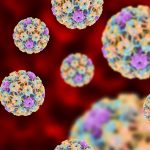Menorrhagia Identifying and Treating Bleeding Disorders in Your Patients
Heather Paulson, ND, FABNO
Due to gynecological challenges, bleeding disorders present serious consequences for women and girls. Complications can be encountered during the menstrual cycle, in pregnancy and childbirth, and in menopause. Bleeding disorders can be inherited, hence genetic counseling should be discussed prior to conception or pregnancy. Pregnant women with bleeding disorders have increased risks of complication from epidurals, post-partum hemorrhage, and post-partum or perinatal clotting. In peri-menopause and post-menopause, an undiagnosed bleeding disorder can lead to endometrial hyperplasia and blood clots from hormone replacement therapy. Since bleeding disorders are often overlooked in the differential diagnosis of menstrual problems, most bleeding disorders are not diagnosed until preventable life-threatening consequences have occurred, such as stroke, bleeding events, and fetal harm.Undiagnosed and untreated blood disorders in women have medical consequences and unique issues at every life stage. Delay and/or failure in diagnosing and treating blood disorders in women is a major public health problem, as this can result in significant morbidity, reduced quality of life, days lost from work/school, unnecessary invasive procedures, and high healthcare costs. Although a bleeding disorder is often touted as a “zebra” diagnosis, women with menorrhagia have a 5-24% chance of having a bleeding disorder.1 In fact, heavy menstrual bleeding is often the only clinical sign of a bleeding disorder.
When physicians are adequately trained on the risks and assessment of bleeding disorders, they are more likely to order appropriate testing and assist their patients in assembling a team of hematologists and gynecologists who can help them avoid dangerous clotting and/or bleeding events, as well as unnecessary surgeries.
Identifying Women at Risk of Bleeding Disorders
The first risk factor for bleeding disorders is menorrhagia, which is defined as menstrual bleeding that lasts for 7 days or more, passing blood clots that are at least a quarter in diameter, and changing a pad or tampon at least every 2 hours. More specifically, menorrhagia is defined as 60-80 mL of blood loss per menstrual cycle.2 Each pad or tampon absorbs between 5-10 mL of blood, depending on the brand.
A more objective method for measuring menstrual blood loss is to run serum ferritin levels. Any serum ferritin less than 12 ng/mL (or 12 mcg/L) is considered indicative of iron deficiency anemia.3 An optimal ferritin level for menstruating women is between 40 and 60 ng/mL.4
While gathering family history information, there are a couple of red flags to keep a look out for when considering a bleeding or clotting disorder. These red flags include:
Having a relative with an inherited bleeding condition
Having a relative that has undergone hysterectomy for no other reason but bleeding
Having a relative needing treatment for bleeding following trauma, dental procedure, childbirth, or heavy menses
A woman may present with a menstrual cycle that has a flooding or gushing sensation, chronic anemia since onset of menses, heavy bleeding since menarche, or post-partum hemorrhage that required intervention. If she complains of bleeding gums, epistaxis, or a family history of bleeding symptoms, recurrent miscarriages, or bleeding during pregnancy, consider a referral to a hematologist.
Common Bleeding and Clotting Disorders in Women
Von Willebrand Disease
Von Willebrand Disease (vWD) is the most commonly inherited bleeding disorder in American women.1 It is the American College of Obstetrics and Gynecology’s position that every woman with menorrhagia should have vWD worked up as part of a differential diagnosis.1
Von Willebrand Factor (vWF) is an adhesive protein stored in the cytoplasmic organelles in endothelium platelets. vWF is released from these stores in response to a stimulus. Its function is to mediate platelet adhesion to damaged vessel walls, induce platelet aggregation, and serve as a carrier protein for Factor VIII. Individuals with vWD are deficient in vWF, hence require more time to form clots and stop bleeding.
Women with vWD are at high risk for post-partum hemorrhage 5 to 14 days post-partum. This is because vWF naturally falls post-partum. Some other activities that affect vWF and Factor VIII include stress, exercise, hormones, and phase of the menstrual cycle. The use of oral contraceptives can increase vWF and Factor VIII levels. Always obtain lab measurements on a patient before initiating hormone therapy.
Treatments for vWD includes combined oral contraceptives, progestins, desmopressin, antifibrinolytics, and fibrin glue or thrombin powder. Combined oral contraceptives can reduce menstrual blood loss by 50% by increasing plasma Factor VII and vWF.
A woman with vWD should be advised to avoid non-steroidal anti-inflammatory drugs (NSAIDs) and blood thinners such as warfarin, antiplatelet medications, and herbal or natural blood thinners.
Thrombophilia
Thrombophilia affects 5-8% of Americans.5 Thrombophilia is caused by a mutation in Factor V and prothrombin genes, a deficiency in protein S, anti-thrombin, or protein C, or by a genetic mutation in the methylenetetrahydrofolate reductase (MTHFR) gene. Thrombophilia is the leading cause of maternal death.6 You may want to include thrombophilia in your differential diagnosis if your female patient has experienced complications from pregnancy, complications from OCPs or hormone replacement therapy, and/or any clotting events such as a deep vein thrombosis (DVT) or pulmonary embolism (PE). An estimated 50-70% of DVT and PE events happen in patients with an underlying thrombophilia.7 Thrombophilia has been associated with infertility and pre-natal complications. Thrombophilia should be ruled out if a patient has had recurrent miscarriages, severe preeclampsia, fetal growth restriction, fetal stroke, fetal infarcts, fetal thrombosis, or placental abruption. The main treatments for thrombophilia are heparin/warfarin and folate.
Laboratory Tests to Rule Out Bleeding or Clotting Disorders
A Menorrhagia Profile can include the following lab tests:
- Activated partial thromboplasmin time (aPTT)
- Factor VIII activity
- Factor IX activity
- Factor XI activity
- Prothrombin time (PT)
- von Willebrand Factor antigen
A Thrombotic Profile can include the following lab tests:
- Dilute prothrombin time
- Antithrombin activity
- Protein C-Functional
- Prothrombin Antibodies, IgG
- Prothrombin Antibodies, IgM
- Plasminogen
- Activated Protein C resistance
- Antiphophatidylserine, IgM
- Antiphosphatidylserine, IgA
- Factor II (Prothrombin)
- Methylenetetrahydrofolate reductase (MTHFR) polymorphism
- Factor V Leiden
- Factor V activity
- Protein S antigen
- D-Dimer
- Fibrinogen antigen
- Protein C antigen
- Treatments
Hormonal Therapies
- Combined oral contraceptives
- Depot medroxyprogesterone acetate
- Levonorgestrel-releasing intrauterine system (IUS)
- Danazol
- Gonadotropin-releasing hormone analogs
Non-Hormonal Therapies
- Antifibrinolytic agents
- Desmopressin
- Iron replacement
Herbal Treatments
A combination of uterine styptics and uterine tonics may be beneficial in reducing heavy menstrual bleeding. Some uterine stypics include Geranium maculatum and Capsella bursa-pastoris (shepherd’s purse). Uterine tonics to consider include Vitex agnus-castus (chaste berry), Avena sativa (oatstraw), Taraxacum (dandelion) root and leaf, Urtica dioica (nettles), Angelica sinensis (dong quai) root, and Rubus idaeus (raspberry).
There are also well known herbal fibrinolytics, which may be helpful in thrombophilic diseases but should be avoided in bleeding disorders such as vWD. These include Curcuma longa (turmeric), Zingiber officinale (ginger), Ginkgo biloba, Panax notoginseng, Salvia miltiorrhiza (Danshen), Crocus sativus (saffron), and Vinca minor (periwinkle).
An herb that may be helpful for both stopping bleeding and promoting blood flow is Panax notoginseng. Studies have shown the herb to inhibit platelet aggregation and thrombosis while simultaneously stopping bleeding.8
The Critical Role of Primary Care
As primary care physicians, we play a critical role in properly identifying women with bleeding and clotting disorders. The patients I have worked with in my office have undergone intense iron therapy, surgeries, strokes, DVTs, and consulted several specialists before anyone ever considered a hematological disorder as part of the work-up. By identifying women in your practice who are at risk for these life-threatening complications, you could be saving lives. It is time to help hematological conditions become less of a zebra diagnosis and more of a real contender for differential diagnosis, work up, and treatment.
 Heather Paulson, ND, FABNO, focuses on helping people diagnosed with cancer and hematological disorders reconnect with their natural state of wellness. Dr Paulson is a Fellow of the American Board of Naturopathic Oncology, denoting this specialized training and focus in her practice. She teaches oncology and hematology at Southwest College of Naturopathic Medicine and also maintains a private practice at The Paulson Center in Tempe, AZ.
Heather Paulson, ND, FABNO, focuses on helping people diagnosed with cancer and hematological disorders reconnect with their natural state of wellness. Dr Paulson is a Fellow of the American Board of Naturopathic Oncology, denoting this specialized training and focus in her practice. She teaches oncology and hematology at Southwest College of Naturopathic Medicine and also maintains a private practice at The Paulson Center in Tempe, AZ.
References
- The American College of Obstetricians and Gynecologists. Von Willebrand Disease in Women. Committee Opinion. December, 2013; 580. ACOG Web site. http://www.acog.org/Resources-And-Publications/Committee-Opinions/Committee-on-Adolescent-Health-Care/Von-Willebrand-Disease-in-Women. Accessed September 1, 2014.
- National Heart, Lung, and Blood Institute. The Diagnosis, Evaluation, and Management of von Willebrand Disease. December, 2007. NHLBI/NIH Web site. http://www.nhlbi.nih.gov/files/docs/guidelines/vwd.pdf. Accessed September 1, 2014.
- Iron Deficiency Anemia. The Merck Manual Professional Edition Web site. http://www.merckmanuals.com/professional/hematology_and_oncology/anemias_caused_by_deficient_erythropoiesis/iron_deficiency_anemia.html. Accessed September 1, 2014.
- Boost Your Iron Levels With Good Nutrition and Proper Supplementation. August 20, 2014. Healing the Body Web site. http://www.healingthebody.ca/boost-your-iron-levels-with-good-nutrition-and-proper-supplementation/. Accessed September 1, 2014.
- Genetic Clotting Problems. APS Foundation of America, Inc. Web site. http://www.apsfa.org/links21.htm. Accessed September 1, 2014.
- Kutteh WH, Triplett DA. Thrombophilias and recurrent pregnancy loss. Semin Reprod Med. 2006;24(1):54-66.
- Ageno W, Agnelli G, Imberti D, et al. Risk factors for venous thromboembolism in the elderly: results of the master registry. Blood Coagul Fibrinolysis. 2008;19(7):663-667.
- Yang X, Xiong X, Wang H, Wang J. Protective effects of panax notoginseng saponins on cardiovascular diseases: a comprehensive overview of experimental studies. Evid Based Complement Alternat Med. 2014;2014:204840.









